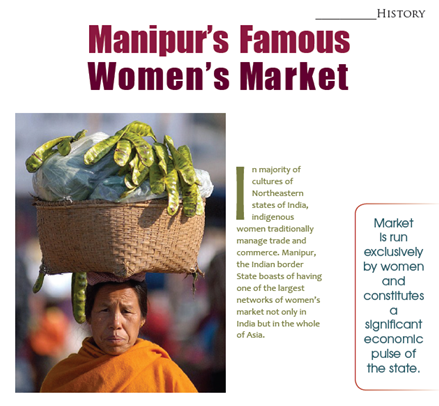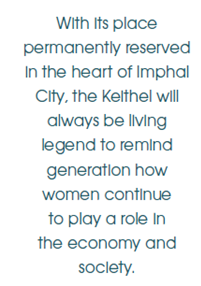
In majority of cultures of Northeastern states of India, indigenous women traditionally manage trade and commerce. Manipur, the Indian border State boasts of having one of the largest networks of women’s market not only in India but in the whole of Asia.
Markets are called Keithel in Manipur and exhibit a sophisticated system of trade. The term market seems inadequate to describe what a Keithel really is and the role it plays in the local economy, culture and society. Kei translates as storehouse while thel means display, loosely translating into display of store for exchange of goods either through barter or money.
The Nupi Keithel or women’s market in the heart of Imphal is the mother of all the Keithels in Manipur. It is the biggest as well as most important of all women’s market. The market is run exclusively by women and constitutes a significant economic pulse of the state. Nupi Keithel and its off-springs are collectively known as Khwairamband Keithel. It is said Nupi Keithel is the off-shot of the first market known as Sana Keithel or Royal Market.
Though the exact date of the introduction of Sana Keithel is obscured in antiquity, nevertheless it can be said with certainty that the idea of Keithel is not of recent origin. Lamitlon, a book which deals with naming of geographical areas of the erstwhile Kingdom of Manipur, validates the existence of Keithel when it mentioned that Maharaj Chalamba who reigned from 1545 to 1562 AD erected a big stone to mark the site of the Sanakeithel. It goes on to say - Maharaj Mungyamba actually founded the Sanakeithel in 1580s.
antiquity, nevertheless it can be said with certainty that the idea of Keithel is not of recent origin. Lamitlon, a book which deals with naming of geographical areas of the erstwhile Kingdom of Manipur, validates the existence of Keithel when it mentioned that Maharaj Chalamba who reigned from 1545 to 1562 AD erected a big stone to mark the site of the Sanakeithel. It goes on to say - Maharaj Mungyamba actually founded the Sanakeithel in 1580s.
According to the Royal Chronicles of Manipur, the Cheitharol Kumbaba, indications are that the Sanakeithel was originally established inside the Royal Kangla fort. Sanakeithel, in subsequent years, was shifted out of the western side of the Kangla fort. This market would gradually give way to what is now known as the Nupi Keithel.
Another ancient text, the Khamnung Engal Leishaba, shade light to the mythological origin of the Keithel by associating its first existence with the Lairembis or Goddesses taking to selling local produce to ensure peace, tranquility and development. The annual ritualistic observation of Lai Keithel Kaba, meaning Gods taking the Market is testimony to this claim.
Nupi-Keithel, also known as the Purana Market is the oldest of the existing markets while Laxmi Bazar and the New Market are new editions. Located in the east is the New Market, housing handloom traders, specializing in Phanek or Sarong and the delicate Phis - the wraparounds of the women. The one on the south flank is popular as the Laxmi Bazar. It is where household items such as bed sheets, bed-covers and mosquito nets are sold; Shawls and towels, being common to both the new markets.
To the west of the ‘new market’ on the left banks of Nambul River, near the hump-backed bridge was where a small male-market flourished. Though only women are known to indulge in domestic and internal trading, the new phenomena of running the market by males came about when women abstained from taking to the market in protest against the high tax levied on them by the British. This male-market came to be known as the Nupa Keithel.
The three markets, along with the Nupa Keithel, are what now collectively referred to as the Khwairamband Keithel or Khwairamband Bazar.
Apart from the economic activities, the market also serves as an important venue of social and political interaction. Manipur has a patriarchal society but in the Keithel, women are encouraged to be individually self-reliant and collectively powerful. It is here, political consciousness and group solidarity is developed and strengthened. It is this dynamic aspect of this market that played a crucial role in the outbreak of the two Great Women Revolts.
At least on two occasions, first in 1904 and again in 1939, they rose against the exploitative colonial British policies and asserted themselves in what came to be known as the NUPI LAN or Women’s War. Nupi Lan unveiled the collective potential of the women for national cause.
Every Keithel in Manipur is founded in methodical and mystical ways. Each market place has a sacred site for the Deity or Deities. Before starting the day’s trading, betel nuts and leaves, fruits, flowers and other items are offered for good trading. In Nupi Keithel, there is a sanctum for Keithel Lairembi and Lairemba, - male and female deities of the market.
The stalls that make-up the Nupi Keithel are well laid out in accordance with directional principles. The south eastern corner is reserved for selling gold, silver, copper and other precious metals. North-east is reserved for selling of rice while north-west for paddy. The south-western side is exclusively for fish.
Sunzu Bachaspatimayum
To read the further articles please get your copy of Eastern Panorama March issue @http://www.magzter.com/IN/Hill-Publications/Eastern-Panorama/News/ or mail to contact @easternpanorama.in


